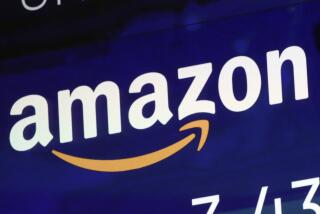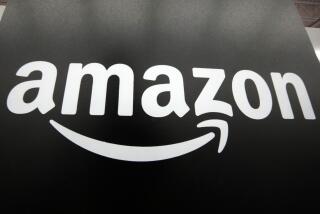Amazon Reports Its First Profit
- Share via
The Internet revolution, which promised to transform the way consumers shop for everything from compact discs to cars, reached a grand milestone Tuesday when pioneering online retailer Amazon.com Inc. reported the first profit in its seven-year history.
In the last three months of 2001, the world’s largest electronic commerce company cleared $5 million, or 1 cent a share, contrasted with a loss of $545 million, or $1.53 a share, in the same period a year earlier.
The profit was fueled by robust Christmas sales as the Seattle company sold $1.1 billion of books, videos, consumer electronics and other merchandise in the fourth quarter, a 15% increase from the year-earlier period.
Although analysts say Amazon may post a loss in the upcoming quarters, they add that the company’s efforts to streamline its operations and consumers’ increasing willingness to shop online appear to have put it on a trajectory toward sustained profit in the coming years.
“They took a very good brand and very good shopping technology and a great customer experience and they finally turned it into a business model that the market can support,” said George Sutton, managing director of RBC Capital Markets in Minneapolis. “This is a good day for e-commerce broadly.”
After losing billions of dollars since it opened its virtual doors in July 1995, Amazon promised Wall Street that by the end of 2001, it would post a pro forma operating profit--a loose measure that excludes routine business expenses such as restructuring costs, amortization of goodwill and the cost of paying employees with stock. By those standards, the company made $59 million in the fourth quarter, contrasted with a loss of $60 million in the fourth quarter of 2000.
Still hanging over the company is $2.2 billion in long-term debt and the continuing challenge of persuading customers to spend increasing amounts online on a regular basis.
But analysts viewed Amazon’s performance last quarter as “exceptionally impressive” considering that the company broke the profitability barrier in the midst of a recession clouded by the war in Afghanistan and the uncertainty of further terrorist attacks, said Jeetil Patel, senior analyst with Deutsche Bank in San Francisco.
“We’re now seeing the proof that the e-retailing business does really work at the end of the day,” Patel said.
Investors rewarded Amazon by bidding up the price of its shares 24% to $12.60, up $2.44 on Nasdaq.
Analysts downplayed the significance of the $5-million profit Amazon reported using “generally accepted accounting principles” because it included factors that are outside its control, even though they benefited the company’s bottom line.
For instance, the value of the company’s European debt has plummeted as the euro has weakened relative to the dollar. In addition, the cost of paying employees in stock--a hallmark of the dot-com era--falls with Amazon’s stock price.
Amazon squeezed out its first profit after a year of aggressive cost cutting. The company consolidated offices, closed a fulfillment warehouse in McDonough, Ga., and shuttered customer service centers in Seattle and Europe. Altogether, Amazon laid off about 1,300 employees in technical, professional and warehouse positions.
As a result, the company’s growth rate slowed in 2001. But that allowed it to get to the point where new customers and incremental sales result in high profit margins, analysts said. Now Amazon is positioned to aim for both.
“This year will be more of a growth year,” Sutton said. “Now they can afford to get more aggressive in terms of growth without sacrificing profits.”
For the first three months of 2002, Amazon executives said, the company expects to have an operating loss of no more than $16 million and could break even. Those would be considered strong first-quarter results for any retailer because retail sales generally hit a lull after the frenetic holiday shopping season.
Analysts are expecting that Amazon will report another profit for the 2002 holiday shopping season--if not sooner--when high sales volume creates operational efficiencies.
The outlook for Amazon today is much different than in 2000, when the dot-com meltdown was in full force. Company observers compared the company’s monthly loss--it’s so-called burn rate--to the amount of cash it had on hand and calculated that it would be out of business by December 2000.
“This is a bad day for the naysayers,” Sutton said.
But the fact that Amazon could be profitable doesn’t mean there will be coattails for other struggling online retailers.
“Does that mean everyone else can do it? No,” Patel said. “Amazon achieved almost $1.2 billion in sales to do so. Not a whole lot of other companies can do that.”
For the full year, Amazon reported a net loss of $567 million, down nearly 60% from the $1.4 billion it lost in 2000.
More to Read
Inside the business of entertainment
The Wide Shot brings you news, analysis and insights on everything from streaming wars to production — and what it all means for the future.
You may occasionally receive promotional content from the Los Angeles Times.











